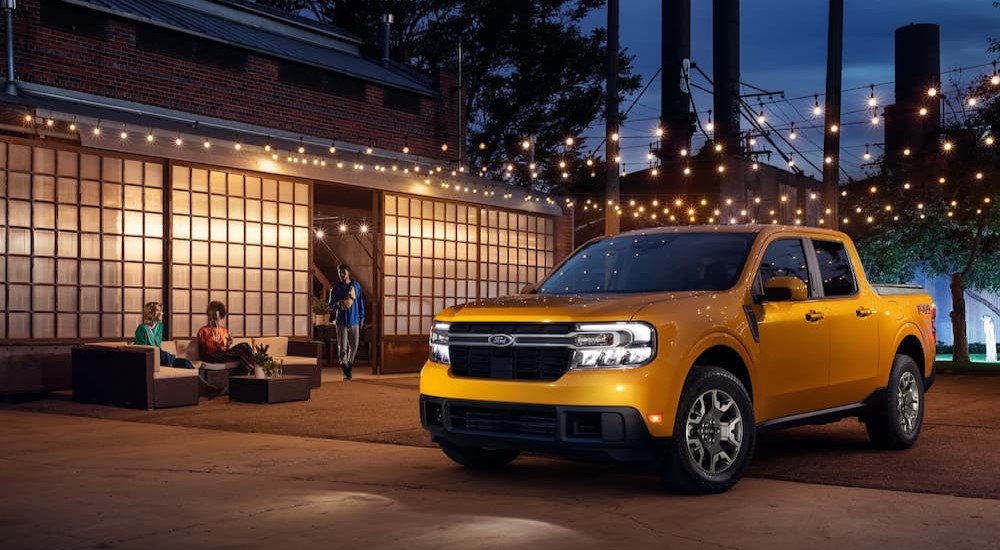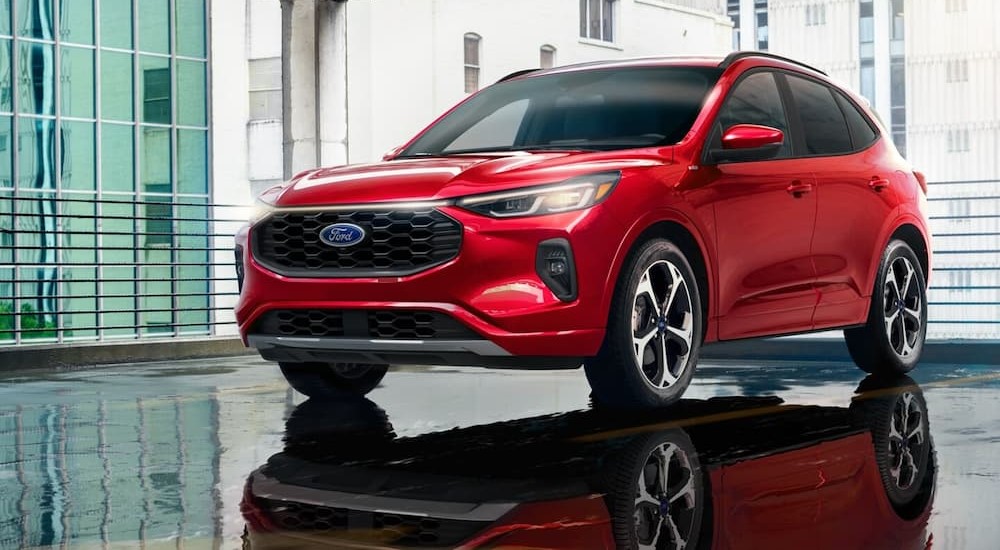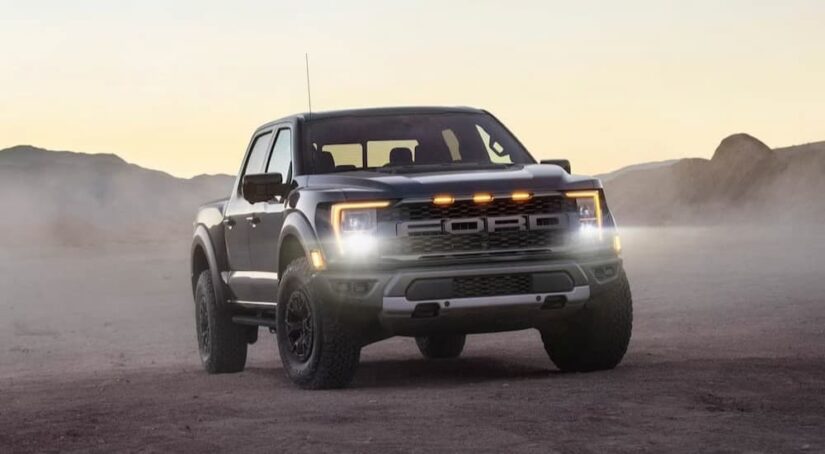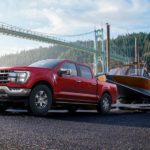If you’ve ever looked around a Ford dealer, you’ve probably noticed that Ford has a lot of different engine options available. The F-Series of trucks alone has multiple V6 options, including one paired with electric motors to create a hybrid powertrain, high-powered V8 engines that deliver extra horsepower, and a diesel-powered V8 for the Super Duty trucks that has high torque for better towing––not to mention the engine-free power setup of the all-electric F-150 Lightning. Beyond its full-size pickup line, Ford also has smaller trucks with more efficient engines, SUVs designed for a whole different driving style, and performance models that need some well-engineered powertrains in order to deliver thrills.
While Ford’s trucks, SUVs, and sportscars are all very different vehicles, they have one thing in common: models across all three segments can be had with an EcoBoost engine under the hood. If you’ve been shopping for a Ford, you’ve probably seen the term “EcoBoost,” and you may have wondered what it actually meant and what makes an EcoBoost engine different from the other engines in Ford’s lineup. If so, you’ve come to the right place because we’re going to clear it up for you right now. Read on to find out what makes EcoBoost engines unique and which Ford models have them available.
What Makes an EcoBoost Special?
There are a lot of different engines used to power Ford vehicles, but only some of them have the EcoBoost moniker. That’s because this isn’t a brand name that’s just slapped on engines arbitrarily. In order to be called an EcoBoost, an engine needs to use three distinct technologies, which are designed to work together for a solid balance of power and efficiency. This is the meaning behind the name, by the way—the “eco” represents fuel efficiency, while the “boost” represents the boost of power Ford wants you to feel every time you hit the accelerator.
The first technology present in all EcoBoost engines is turbocharging. Turbocharged engines capture energy in the exhaust that would otherwise simply be wasted and use it to turn a turbine that forces more air into the engine. This process lets small engines generate more power than they would usually be able to. Smaller engines tend to be more efficient, and since they’re lighter, you save even more power by not hauling around a big block engine everywhere you drive. This can ultimately result in better fuel economy.
Technology number two is direct fuel injection. In an engine that uses traditional port injection, fuel and air are mixed together in the intake manifold before entering the engine’s cylinders. By contrast, direct injection engines inject fuel into the cylinders directly. If you’re confused, don’t worry—you don’t have to understand the inner workings of an internal combustion engine to learn the benefits of direct injection. Basically, it lets the car burn fuel more precisely, so you only use as much as you need and no more. If you’re cruising along and not towing anything, the injectors will give the engine a pretty low amount of fuel, but if you’re hauling cinder blocks up a hill, they’ll inject more fuel to give you the power you need. You won’t have to waste a large amount of fuel for easy driving, but you’ll also have the ability to tackle more difficult driving if conditions change.
Finally, all EcoBoost engines use twin independent variable camshaft timing. You’ll often see this abbreviated as Ti-VCT when looking at the names of Ford’s engines. Instead of opening and closing intake and exhaust valves regardless of how much power is being used, the engine controls the timing of when they’re opened and closed to maximize power when it’s needed and minimize how much fuel is burned. This improves the engine’s fuel economy and reduces emissions while also enhancing power when you need it.

What Models Use EcoBoost Engines?
Finding a model in Ford’s lineup with an EcoBoost engine under the hood is like finding a strand of hay in a haystack. You can get one in just about any model in Ford’s 2024 lineup that isn’t a hybrid or an EV, and many models have multiple EcoBoost options that provide different levels of power (at different price points, of course). Ford is pretty good about labeling its EcoBoost engines with the brand name, so you shouldn’t have to guess whether or not a vehicle you’re looking at has one.
Other than the Mustang Mach-E, you can find EcoBoost options across Ford’s SUVs. The compact Escape has a 1.5L EcoBoost as the standard powertrain and a more powerful 2.0L EcoBoost as an available upgrade. There are also hybrid options for the Escape, but while they’re more fuel efficient, they can’t match the towing capacities of models equipped with an EcoBoost. Moving up, both engine options for the midsize Edge are EcoBoosts: an efficient 2.0L I-4 and a more powerful 2.7L V6. The Explorer is also a midsize SUV and has a very similar duo of engines: a 2.3L EcoBoost I-4 and a 3.0L EcoBoost V6. The full-size Expedition needs a larger engine to move it around, so it features a 3.5L EcoBoost that can produce up to 440 hp, allowing it to tow up to 9,300 lbs.
The Bronco and, to a lesser extent, the Bronco Sport are designed for off-roading, which means they need to produce plenty of power for tackling rough terrain and providing good handling for fun times out in the open desert. The Bronco Sport is the milder of the two, but can still boast some solid performance with the available 2.0L EcoBoost, which cranks out 250 hp. The standard 1.5L EcoBoost is better for light adventures and cruising around town. The big Bronco comes with a base engine even more powerful than the optional upgrade for the Bronco Sport: a 2.3L EcoBoost I-4 that produces 300 hp and 325 lb-ft of torque. Upgrade to the 2.7L EcoBoost V6, and you can trade a bit of fuel economy for 330 hp and 415 lb-ft of torque, allowing you to handle a wider range of off-road situations. The extra-rugged Bronco Raptor gets its own unique engine: a 3.0L EcoBoost V6 that’s tuned specifically for major off-roading expeditions and produces 418 hp and 440 lb-ft of torque.
Ford has a full array of trucks, and many of them use EcoBoost engines to get down to business. The compact Maverick used to have a standard hybrid powertrain, but now it comes standard with a 2.0L EcoBoost engine that allows you to take advantage of its full 4,000 lb towing capacity. The hybrid is still available, however, for those who prioritize fuel economy. The midsize Ranger comes standard with an efficient 2.3L EcoBoost I-4 engine that’s perfect for on-road driving. If you’re looking for something with enough power to take you off-road, you can upgrade to the 2.7L EcoBoost V6. The Ranger Raptor has a unique 3.0L EcoBoost V6 that churns out 405 hp and 430 lb-ft of torque.
The 2.7L EcoBoost V6 may be an available upgrade on the Ranger, but it’s the standard powertrain on the F-150. If its 325 hp isn’t enough for you, then you can step it up with the 3.5L EcoBoost V6, which produces 400 hp and 510 lb-ft of torque to unlock a maximum towing capacity of 13,500 lbs. The F-150 Raptor, as you might have guessed, has its own specially tuned engine: a High-Output 3.5L EcoBoost that generates 450 hp so off-road adventurers can get their kicks. The F-150 also has several non-EcoBoost engine options, including a 5.0L V8 and a turbocharged 3.5L V6 that is paired with electric motors to form a hybrid powertrain. The Ford SuperDuty is focused on high towing and hauling capabilities, not a balance between power and efficiency, so you won’t find any EcoBoost options in the 2024 lineup.
Finally, let’s take a look under the hood of Ford’s performance car: the Mustang. While the 500 hp non-EcoBoost V8 may be the engine enthusiasts drool over, the more affordable and efficient 2.3L EcoBoost I-4 option holds its own pretty well, delivering 315 hp and 350 lb-ft of torque. Thanks to improvements in engineering over the years, the 2024 model with this engine is faster than any other four-cylinder Mustang in the nameplate’s history. Independent testing recorded this Mustang as having a 4.5-second zero to 60 mph time, which isn’t half bad for an engine that small.

The Reign of the EcoBoost
The formula of the EcoBoost engine has clearly been working for Ford. Almost all of the automaker’s 2024 models have at least one EcoBoost engine option, and many have several or even exclusively feature these engines. This might not be the case forever, as once-new technologies like direct fuel injection and turbocharging make way for hybrid and EV powertrains, but today, these engines still offer drivers a solid balance between fuel economy and power that makes sense in a lot of situations. If nothing else, the EcoBoost is a uniting force that brings together everyone from truck-driving tradesmen to suburban families to performance enthusiasts.



